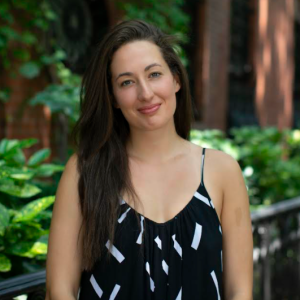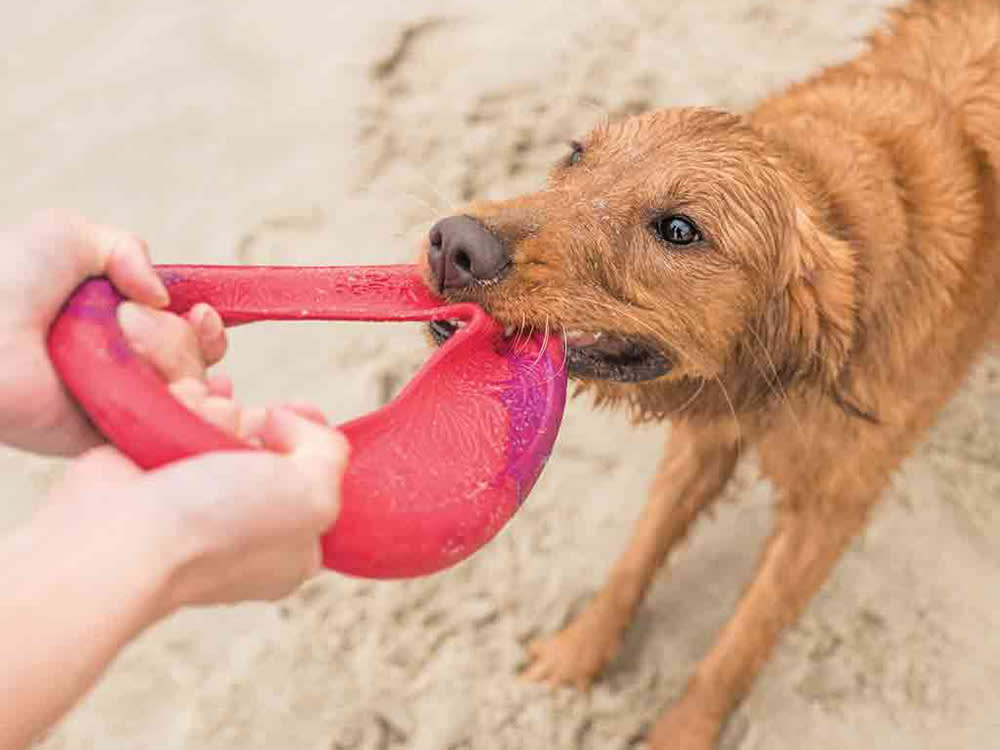West Paw Is Leading the Pack in Pet Sustainability
Founder Spencer Williams shares his top tips for pet parents looking to lighten their impact.

Share Article
As Spencer Williams greets me from the Bozeman, Montana headquarters of his company West Paw Incopens in a new tab., my gaze goes right through the glass wall in his office, onto the manufacturing line churning out recycled dog toys behind him. Even from a Zoom screen, it’s easy to get a feel for the heritage business that got its start in 1996 but really traces back through five generations of Williams’s who have lived and worked in Montana.
Today, West Paw remains an ode to the local community, a leader in the sustainable pet movementopens in a new tab, and a treat for dog parents looking to buy thoughtfully and transparently made products for their pet. I chatted with Williams about his inspiration to start the company, how they’re doing things differently, and where he wants to take it next. Today, he answers me solo but notes that his pup Niko, a six-year-old Poodle, is usually there to chime in from his spot on one of the company’s signature dog beds — also made just beyond the glass.

Save on the litter with color-changing tech that helps you better care for your cat.
What was your inspiration for starting West Paw?
I knew I wanted to come back to Montana to work, and manufacturing really resonated with me because of the impact it could have on the community. Back when I started the company, my then-fiancé, now wife, and I were just crazy for our chocolate Lab. At the time, a friend told me about a woman who was a great sewer of cat and dog toys. She had been in business for several years and wanted to sell it. It was the perfect opportunity for me to learn from her, so I jumped in with both feet.
Fast forward to today, and you’re the first pet product manufacturer to earn a B Corp certification. Can you talk through what it means to be a B Corp and why that was something you wanted to pursue?
We became certified as a B Corpopens in a new tab in 2013. In order to get certified, you have to score 80 points or higher on a scale of 200, and you’re rated on five impact areas: Governance, Workers, Community, Environment, Customers. A big reason we became a B Corp was that we wanted to be part of a movement to drive change. As one small company in Montana, you wonder how much impact you can really have. But when you’re a B Corp, you scale that impact because now you’re part of a movement.
In the years since then, we’ve also been a co-founder in the Pet Sustainability Coalitionopens in a new tab which provides resources and consulting to help encourage more sustainability in our industry. It started with eight co-founding members, and now there are up to around 175 members: Everybody from Petco to small independent retailers.
How does this commitment to sustainability translate to the treats that you sell?
I grew up on a ranch and it’s very obvious to me that our food system in this countryopens in a new tab is broken. Oftentimes, beef prices are through the roof but the producers — the ranchers — are not getting any of the money. One of the things I noticed when touring cutting room floors of slaughterhouses around Montana and Wyoming is that the organ meat often goes to waste. That costs the producers money because it’s good protein that’s getting left behind.
That’s why we use organ meat as the primary ingredient in our treats. We use the heart, liver, and lungs of bison, beef, and turkey to help ensure that these healthy proteins that the Earth put a lot of resources into growing don’t go to waste. We also focus on humanely raised, sustainably sourced, U.S.-origin, natural ingredients across the board. They’re better for the dog, and better for the farm animal.
What about your toys — how are you doing those differently?
So many dog toys don’t get recycled and are full of heavy metals, BPA, and phthalates. When we introduced our Zogoflex toy lineopens in a new tab 18 years ago, we wanted to create a durable, safe, U.S.-made product that could be recycled through a close-the-loop program. Anybody can recycle any Zogoflex toy through retailers or send it directly to West Paw. Right behind me, we grind it up, clean it, and make brand new toys out of it.
Our new dog toy line, Seaflexopens in a new tab, also uses around 11% ocean-bound plastic. That product line is something I’m super proud of because we all know that ocean-bound plastic is a huge issue. We’re really focused on keeping it from getting into the ocean in the first place by capturing it on land, cleaning it up, and helping get it back into really awesome products that dogs love.
Speaking of, does Niko have a toy or West Paw product he loves the most?
His favorite toy is the Seaflex Snorklopens in a new tab. He can hold one end and I’ll hold the other end to play tug, or he just loves to chew on it. Between the Snorkl and his Heyday bedopens in a new tab, he’s a happy dog — but the treats are what make him really good. He’ll do anything for the bison lung. Oh my gosh, he suddenly becomes the best-behaved dog on the planet when those are around.
I know sustainability is becoming more important for a lot of eco-conscious pet parents. What are a few ways people can start reducing their pet’s impact?
Their food has a larger environmental impact than anything, so I think that’s the first place to start: Are you able to feed them something that’s sustainably raised and organic? Maybe you start with just part of the food, a 50-50 mix. Generally speaking, more natural foods are going to be healthier for the pet too. Then, I’d definitely encourage pet parents to look at their accessories next. It doesn’t take much searching today to find pet productsopens in a new tab that are either recyclable or recycled.
Third, there’s the packaging. Most treats and dog food are packaged in a multi-layer resin: You might have a layer of foil to keep the fats in the food, then you have a layer of polyethylene plastic or something else. These layers stop the recyclability, so I’d recommend a single-layer resin (which West Paw recently switched over to!).
What’s next for West Paw?
As a company, we’re so grateful for our team here and the fact that we can make our products in Montana. We’re going to continue to grow this brand and hopefully inspire other brands to be more sustainable and create longevity in our business. We’re a 25-year-old company and we want to make sure we go through the next 25 years really strong.
* The interview has been edited for brevity and clarity.

Emma Loewe
Emma is a writer, editor, and environmentalist based in New York City. She is the senior sustainability editor at mindbodygreen, the author of Return To Nature: The New Science of How Natural Landscapes Restore Us (April 2022), and the co-author of The Spirit Almanac: A Modern Guide To Ancient Self-Care. While she doesn’t have any pets of her own, she is a loving dog aunt to Pip the pup.
Related articles
![Golden dog laying on patterned Jax & Bones bed in living room]() opens in a new tab
opens in a new tabSoda Bottles & Fabric Scraps Get A Playful Reimagination In Jax & Bones
Tina Nguyen couldn’t find stylish, sustainable, and locally produced products for her dog — so she made them herself.
![Hiker and dog overlooking the top of a mountain]() opens in a new tab
opens in a new tab8 Ways to Be a More Eco-Friendly Pet Parent in 2025
Expert tips to help reduce your pet’s carbon footprint. (Pawprint? You get it.)
![Bullmastiff puppy chewing on a purple ring chew toy]() opens in a new tab
opens in a new tab11 Tough Toys for Power Chewers
Veterinary behaviorist Dr. Valli Parthasarathy reccos the most durable dog toys for destructive players.
![A woman sitting at a dining room table with a dog.]() opens in a new tab
opens in a new tabHouse Dogge Makes Sustainability Feel Effortlessly Cool
Former Nike Design Director Angela Medlin on applying her streetwear savvy to eco-conscious pet products.







